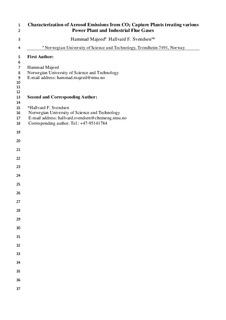| dc.contributor.author | Majeed, Hammad | |
| dc.contributor.author | Svendsen, Hallvard Fjøsne | |
| dc.date.accessioned | 2019-04-02T12:17:22Z | |
| dc.date.available | 2019-04-02T12:17:22Z | |
| dc.date.created | 2018-10-22T21:10:23Z | |
| dc.date.issued | 2018 | |
| dc.identifier.citation | International Journal of Greenhouse Gas Control. 2018, 74 282-295. | nb_NO |
| dc.identifier.issn | 1750-5836 | |
| dc.identifier.uri | http://hdl.handle.net/11250/2592945 | |
| dc.description.abstract | Undesired aerosol formation in gas–liquid contact devices has been a well-known phenomenon in the chemical industry for several decades and can cause severe problems in industrial gas cleaning processes. Several studies indicate that aerosols can govern the total amine emissions from amine based CO2 capture (PCCC) plants. Despite the importance of aerosol formation and mitigation for the design of a PCCC plant, very little knowledge is available on the characterization and growth of these aerosols.
Four different atmospheric flue gases were modelled in this work, ranging from 4 to 20% in CO2 content and representing natural gas, oil and coal fired power plants, and gas from the cement industry. Inlet droplets of size 0.15 μ were tested in number concentrations from 1 to 107 droplets/cm3. For 20% CO2, the effect of intercooling was studied.
The findings are: Aerosol droplets grow from their initial size regardless of their initial composition and type of flue gas processed. The initial composition of the droplets has a significant effect on emissions.
With increasing CO2 concentration, more carbamate is formed relative to free MEA. This leads to less effective water wash and significantly higher final emissions.
With low droplet number concentration no visible depletion of MEA in the absorber and water wash sections was found for any of the CO2 concentrations. At 107 droplets/cm3, gas phase MEA partial pressure changes are clearly seen, first in the water wash, and then, at higher contents, the effect starts lower and lower down in the absorber.
The carry-over of amine into the water wash increases with increasing gas phase CO2 content. However, the effect on the gas phase MEA content in the water wash goes through a maximum caused by strong carbamate formation at high CO2 concentrations.
The droplet temperature profiles are unaffected by number concentration and initial composition of aerosol droplets.
It is found that the water wash section reduces significantly the aerosol-based, and thereby the total, amine emissions. The effect of the water wash is reduced when the flue gas CO2 content increases.
Intercooling lowers the partial pressure of MEA in both absorber and water wash significantly. This reduces the droplet growth and MEA content. The combined effect is a strong reduction in MEA emissions; in the case of 20% CO2 in the flue gas, by a factor of 5–10. | nb_NO |
| dc.language.iso | eng | nb_NO |
| dc.publisher | Elsevier | nb_NO |
| dc.rights | Attribution-NonCommercial-NoDerivatives 4.0 Internasjonal | * |
| dc.rights.uri | http://creativecommons.org/licenses/by-nc-nd/4.0/deed.no | * |
| dc.title | Characterization of aerosol emissions from CO2 capture plants treating various power plant and industrial flue gases | nb_NO |
| dc.type | Journal article | nb_NO |
| dc.type | Peer reviewed | nb_NO |
| dc.description.version | acceptedVersion | nb_NO |
| dc.source.pagenumber | 282-295 | nb_NO |
| dc.source.volume | 74 | nb_NO |
| dc.source.journal | International Journal of Greenhouse Gas Control | nb_NO |
| dc.identifier.doi | 10.1016/j.ijggc.2018.04.016 | |
| dc.identifier.cristin | 1622440 | |
| dc.description.localcode | © 2018. This is the authors’ accepted and refereed manuscript to the article. Locked until 26.5.2020 due to copyright restrictions. This manuscript version is made available under the CC-BY-NC-ND 4.0 license http://creativecommons.org/licenses/by-nc-nd/4.0/ | nb_NO |
| cristin.unitcode | 194,66,30,0 | |
| cristin.unitname | Institutt for kjemisk prosessteknologi | |
| cristin.ispublished | true | |
| cristin.fulltext | postprint | |
| cristin.qualitycode | 2 | |

